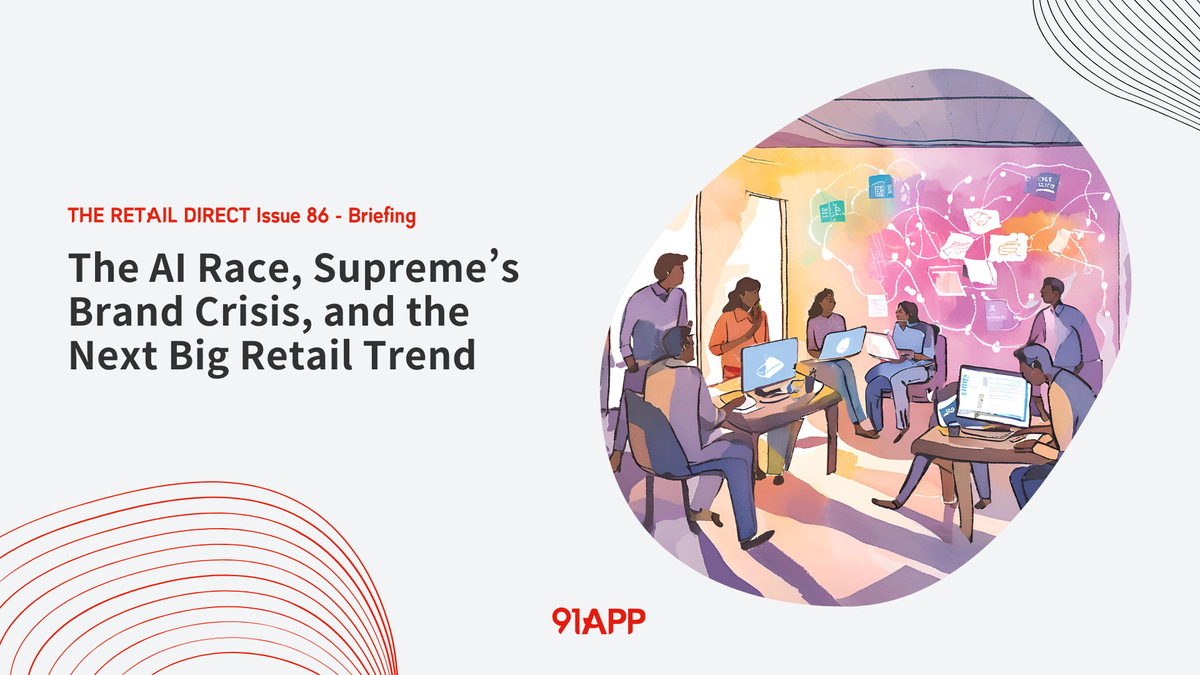TRD Issue 86 - Briefing: The AI Race, Supreme’s Brand Crisis, and the Next Big Retail Trend
AI is transforming retail, Supreme is losing its edge, and Vietnamese coffee is trending. Here’s what’s shaping the week ahead.

Hello Subscribers,
Kicking off the week with some big shifts in AI, retail, and branding. Meta AI is taking off in India, making it Meta’s largest market for AI usage just months after launch. TikTok’s massive AI spending drives Microsoft’s cloud growth, but how long before ByteDance builds its model and cuts ties?
On the brand side, Supreme’s losing its edge—proof that exclusivity and aggressive expansion don’t always mix. Meanwhile, Vietnamese coffee is having a moment, breaking into national retailers as U.S. consumers embrace robusta. In digital advertising, retail media networks are expanding fast, but with concerns over transparency and inventory limits, are they setting themselves up for a reckoning?
Let’s get into it. Happy reading!
The Retail Direct
About 91APP
Founded in 2013, 91APP is the premier OMO (online-merge-offline) SaaS company, providing one-stop omnichannel retail solutions in Taiwan, Hong Kong, and Malaysia. It offers advanced Commerce Solutions and Marketing Solutions that enable retail brands to penetrate the D2C (Direct-to-Consumer) e-commerce market and drive operational benefits to their full potential. In 2021, 91APP became the first SaaS company to be listed in Taiwan and has been named one of Taiwan's "NEXT BIG" companies by Startup Island TAIWAN.
For more information about 91APP (TWO: 6741), visit 91app.com.
AI
Meta AI Surges in India, Becomes Largest Market

Why it matters: India has become the top market for Meta AI usage, signaling the country’s growing influence in global AI adoption—primarily through WhatsApp’s 500 million users.
What’s new
- Meta CFO Susan Li revealed that India leads Meta AI engagement months after its launch.
- Billions of queries have been made, with WhatsApp showing strong retention and engagement.
- Meta AI launched in the U.S. in 2023 and expanded globally in April 2024 with the Llama 3 model.
Challenges & Adjustments
- Cultural hurdles: Meta AI initially misrepresented Indian diversity, generating biased images and jokes.
- Algorithm tweaks: Meta made changes after backlash over AI-generated religious jokes.
Bigger picture
- Meta AI now supports multiple languages, including Hindi and Hindi-Romanized.
- Available in 22 countries, with recent expansion in Latin America.
- Zuckerberg says Llama 4 will need 10x more computing power than Llama 3.
Beyond AI
- Threads has nearly 200M users, continuing its challenge to X (formerly Twitter).
- Facebook is gaining traction among young adults in the U.S.
Meta’s AI push in India reflects its broader global expansion strategy, with WhatsApp as a key growth driver.
Source: TechCrunch
TikTok Fuels Microsoft’s AI Boom, But Risks Loom

Why it matters: Microsoft’s AI revenue relies heavily on a few major customers, with TikTok accounting for nearly 25% of Azure OpenAI Service sales. But TikTok’s parent company, ByteDance, is developing its own AI, threatening future spending.
Key points
- TikTok was paying ~$20M/month for OpenAI models via Microsoft as of March.
- Walmart, Intuit, and G42 are also major AI customers, spending millions monthly.
- Microsoft faces risk if TikTok shifts to its own AI, reducing Azure revenue.
Bigger picture
- Microsoft’s massive AI investments include $35.4B in new data center commitments.
- In 2024, OpenAI’s direct sales surpassed Azure OpenAI Service, meaning Microsoft isn't the sole AI sales driver.
- Copilot enterprise AI sales are growing, with significant financial firms among the top buyers.
Investor pressure
- Azure’s growth (29%) missed expectations, causing a 4% stock drop in Aug 2024.
- Despite market concerns, Microsoft’s AI business is expanding, but it must diversify its customer base.
Microsoft's AI success hinges on retaining big spenders and expanding beyond volatile customers like TikTok.
Source: The Information
U.S. Commerce Dept. Backs Open AI Models, But Regulation Expands

Why it matters: The U.S. initially endorsed open-weight AI models like Meta’s Llama 3.1 in Aug 2024 but introduced export controls and AI safety regulations, signaling a shift toward stricter oversight.
Key updates
- U.S. Export Controls: In Jan 2025, the Commerce Dept. expanded AI model and chip export restrictions, effective May 15, 2025.
- Licenses are required to export advanced AI models and semiconductors.
- Introduces security and reporting rules for advanced AI systems.
- California’s AI Safety Bill (SB 1047) was passed but was vetoed by Gov. Newsom (Sep 2024) over a lack of empirical analysis and excessive restrictions.
- The bill proposed "kill switches" and whistleblower protections for AI models costing $100M+ to train.
- Newsom pledged to develop AI safety regulations in collaboration with experts.
Regulatory landscape
- EU AI Act compliance begins Feb 2025, enforcing transparency and safety rules that could limit open AI development.
- U.S. NTIA still supports open AI, emphasizing innovation and competition, but calls for active risk monitoring.
Bigger picture
- AI openness vs. regulation is now a global debate, with the U.S. tightening export controls while keeping open AI models available domestically.
- The next phase of AI governance will likely involve new federal AI safety frameworks following California’s legislative efforts.
The U.S. strategy continues evolving—initial openness remains, but export controls and safety measures suggest increasing regulatory oversight.
Source: TechCrunch, AI-supportedexpand the updates by Perplexity
ThredUp Turns to AI to Boost $322M Resale Business
Photo Credit: T. Schneider / Shutterstock
Why it matters: ThredUp is betting on AI-powered search tools to improve customer experience and drive sales as the secondhand apparel market grows, but profitability remains a challenge.
Key updates
- AI search tools launched in Aug 2024 include:
- Semantic search: Understand conversational queries like “Brat summer.”
- Image search: Matches user-uploaded photos with similar items.
- Style Chat: Recommends complete outfits based on user prompts.
- ThredUp aims to reduce search dead ends and make discovery easier across its 4M+ SKUs.
Challenges & reception
- AI struggles with nuance—e.g., it suggested fast fashion for “eco-friendly” outfits.
- Consumer skepticism: An IBM survey found only 1 in 3 shoppers were satisfied with AI chatbots.
- Retail AI adoption is mixed—Levi’s abandoned AI-generated models due to backlash.
Bigger picture
- ThredUp’s revenue hit $322M in 2023, but the company still posted a $71M net loss.
- The U.S. resale market grew 11% YoY to $20B, projected to reach $44B by 2028.
- AI’s success depends on metadata quality, with experts skeptical about consumer adoption but optimistic about operational efficiency.
ThredUp hopes AI-powered personalization will drive engagement, but its long-term impact on sales remains uncertain.
Source: Modern Retail
Sybill Raised $11M to Scale AI Sales Assistant
Image Credit: Sybill
Why it matters: Sybill is betting on AI-driven sales automation to eliminate administrative tasks for sales reps, competing in a crowded but growing market.
Key updates
- $11M Series A led by Greycroft, bringing total funding to $14.5M.
- AI assistant tracks calls, emails, and CRM data, offering context-driven insights beyond meeting notes.
- Focuses on sales reps (not leadership), fueling fast adoption via referrals.
Competitive edge
- Built as a delegatable AI assistant, not just a data tool like Gong, Chorus.ai, or Otter.
- Automates CRM updates, follow-ups, and sales summaries with a retrieval-augmented generation (RAG) pipeline to improve accuracy.
Growth & strategy
- Scaled from $100K to $1M ARR in 9 months (2023), with 500+ paying customers in 30+ countries.
- Leverages word-of-mouth, with 60-70% of new customers from referrals.
- Plans to expand the team from 30 to 40 employees by year-end.
Sybill’s success hinges on its ability to differentiate as an AI-powered assistant rather than just another sales tool.
Source: TechCrunch
Retail
Mars’ $35.9B Kellanova Acquisition Moves Forward
Image Credit: Mars
Why it matters: Mars’ acquisition of Kellanova is set to be its largest deal ever, strengthening its snack industry dominance while facing regulatory scrutiny before finalization.
Key updates
- Shareholder approval: 99.5% of Kellanova shareholders approved the deal in Nov 2024, clearing a major hurdle.
- Transaction details: Mars is acquiring Kellanova for $83.50 per share in an all-cash deal totaling $35.9B, including debt.
- Regulatory review pending: The deal is expected to close in H1 2025, subject to antitrust approvals and financing conditions.
Strategic implications
- Mars plans to double its snacking business over the next decade, leveraging Pringles, Cheez-It, and Pop-Tarts.
- Financing is secured through a mix of cash and new debt to fund the acquisition.
- Kellanova’s Q4 earnings beat expectations, boosting confidence in the merger’s long-term value.
Bigger picture
- Regulatory scrutiny remains a key risk, with antitrust regulators watching large food sector consolidations.
- Mars’ biggest acquisition to date—previously, its largest deal was $9.1B for VCA in 2017.
- Food sector M&A is heating up, with inflation and shifting consumer demand shaping industry trends.
With shareholder backing and financial commitments secured, Mars is on track to finalize its acquisition of Kellanova, but regulatory hurdles remain the final step.
Source: Reuters
How Supreme Lost Its Edge—and Can It Bounce Back?
Image Credit: Supreme
Why it matters: Supreme, once a streetwear icon, has struggled under corporate ownership. VF Corp sold the brand at a loss, and its exclusivity-driven business model clashed with aggressive expansion. Now, under EssilorLuxottica, can Supreme reclaim its cool factor?
Key points
- VF Corp’s $2.1B acquisition in 2020 aimed for rapid growth but led to overexposure and declining demand.
- Sales fell 7% in FY2023 to $523M, with search volume down 30% (2022-2024) and resale demand slipping.
- EssilorLuxottica is acquiring Supreme for $1.5B, down from VF’s purchase price.
What went wrong?
- Oversaturation: Expansion to 17 stores globally diluted exclusivity.
- Corporate ownership hurts the brand identity, making Supreme feel less underground.
- The resale market cooled—Supreme’s share on StockX dropped from 36% (2020) to 16% (2024).
- Too many gimmicky products (e.g., Supreme x Tamagotchi, folding tables, and socks) weakened brand perception.
Can Supreme recover?
- EssilorLuxottica could leverage luxury partnerships, like Supreme’s 2017 Louis Vuitton collab.
- Exclusive, high-end drops could reignite hype, but consumer perception is hard to reverse.
- Competition from Kith, Aimé Leon Dore, and Fear of God makes regaining market dominance difficult.
Supreme’s new owner must balance scarcity with smart growth—or risk fading into another corporate streetwear brand.
Source: Modern Retail
Vietnamese Coffee Gains U.S. Retail Traction
Image Credit: Copper Cow Coffee
Why it matters: Vietnamese coffee is seeing record demand in the U.S., fueled by social media trends, premiumization, and retail expansion—positioning it for mainstream adoption.
Key updates
- Copper Cow Coffee expands to 469 Target stores, growing from a California test run.
- Nguyen Coffee Supply launched in 500 Target stores after entering Whole Foods in 2023.
- Social media has driven interest—Google searches for “Vietnamese coffee” are up 61% YoY.
Why now?
- Robusta’s appeal: Higher caffeine content, chocolatey flavor, and climate resilience vs. arabica.
- Vietnam's tourism boom has sparked curiosity about its coffee culture.
- Retailers are pushing high-end Asian brands, with Copper Cow now in 1,200 Walmart locations.
Bigger picture
- Specialty Vietnamese cafes are opening in U.S. cities—Brooklyn’s Kinhfolk launches this year after sold-out pop-ups.
- TikTok & Instagram have fueled the trend, with viral Vietnamese coffee recipes generating millions of views.
- Premiumization is key—brands like Copper Cow are introducing organic, flavored, and ground Vietnamese coffee to diversify offerings.
Vietnamese coffee is shifting from niche to mainstream, creating big retail opportunities in the U.S. market.
Source: Modern Retail
Marketing
Retail Media Networks Expand, But Risks Loom
Photo Credit: Scott Olson / Getty Images
Why it matters: Retailers are pushing offsite retail media (CTV, social, programmatic ads) to sustain growth. But transparency, ad quality, and profitability concerns could spark a reckoning.
Key updates
- Retail media offsite ad spending to hit $20B in 2024, up from $7.5B in 2023.
- Walmart’s $2.3B Vizio acquisition strengthens its CTV ad dominance.
- Amazon & Walmart lead, while smaller retailers struggle with tech investment & talent gaps.
Challenges ahead
- Limited onsite ad inventory forces expansion into offsite channels.
- Lower profit margins (20-40%) vs. onsite (80-90%) challenge revenue expectations.
- Programmatic transparency risks—data oversharing may dilute value to advertisers.
Bigger picture
- Google’s cookie delay doesn’t slow demand for first-party retail data.
- Retail media are seen as a "must buy" vs. "want to buy"—potential advertiser fatigue.
- Some retailers may acquire media companies to strengthen ad reach.
Retail media is at an inflection point—those who execute offsite growth well could dominate, but missteps may erode advertiser trust.
Source: Retail Dive
ESG
Fashion’s Take-Back Programs Grow, But True Recycling Falls Short
Photo Credit: SuperCircle
Why it matters: More brands are offering take-back programs, but actual textile-to-textile recycling is rare. The apparel industry’s waste problem persists despite growing consumer participation.
Key updates:
- H&M, Zara, Mango, and Target have launched clothing drop-off programs, but most items aren’t recycled into new garments.
- According to the EPA, 84% of clothing still ends up in landfills or incinerators.
- Startups like Debrand, SuperCircle, and Trashie aim to build circular models but face challenges in scaling textile recycling.
Challenges
- Blended fabrics and chemical coatings make fiber-to-fiber recycling difficult.
- Costs are high—recycling a single pair of shoes costs $30-$40.
- Take-back programs often lead to resale, downcycling (e.g., insulation), or export to secondhand markets in Africa and South America.
Bigger picture
- California’s proposed Responsible Textile Recovery Act could force brands to fund reuse and recycling programs.
- Fashion production has doubled in 15 years, with 100B+ garments made annually—offsetting new production remains a challenge.
- Transparency is lacking—many brands don’t track where collected garments end up.
Despite consumer enthusiasm for take-back programs, true circularity remains elusive without stronger recycling tech and policy intervention.
Source: Modern Retail





Comments ()